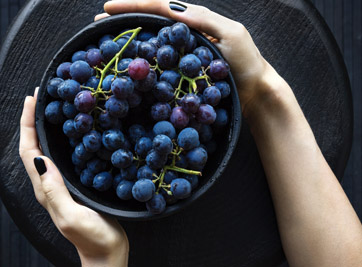
Identifiers
INS No. 163(ii); Grape skin extract
INS No. 163(iii); Blackcurrant extract
INS No. 163(iv); Purple corn color
INS No. 163(v); Red cabbage color
INS No. 163 (vi); Black carrot extract
INS No. 163 (vii); Purple sweet potato color
INS No. 163 (viii); Red radish color
INS No. 163(ix); Elderberry color
INS No. 163(x); Hibiscus color
INS No. 163(xi); Butterfly pea flower extract
Grape color extract
E163
Physical Description
Anthocyanins are obtained by maceration or extraction with sulphited water, acidified water, carbon dioxide, methanol or ethanol from the strains of vegetables and edible fruits, with subsequent concentration and/or purification if necessary. Anthocyanins contain common components of the source material, namely anthocyanine, organic acids, tannins, sugars, minerals etc., but not necessarily in the same proportions as found in the source material.
Blackcurrant extract is obtained from blackcurrant pomace by aqueous extraction. The main coloring principles are four anthocyanins (cyanidin 3-rutinoside, delphinidin 3-rutinoside, cyanidin 3-glucoside, delphinidin 3-glucoside). Grape skin extract occurs as a red to purple powder or liquid concentrate. It is prepared by aqueous extraction of grape marc remaining from the pressing of grapes to obtain juice. The color additive grape color extract is an aqueous solution of anthocyanin grape pigments made from Concord grapes or a dehydrated water soluble powder prepared from the aqueous solution. Butterfly pea flower extract is a dark blue liquid prepared by the aqueous extraction of dried butterfly pea flowers from Clitoria ternatea and contains anthocyanins as the principal coloring component.
Common Uses
Anthocyanins are used to color beverages, confectionary, desserts, ice cream, fruit preparations, bakers jam and non-standard jellies and preserves, sherbets, ices, pops, raspberry, yogurt, gelatin desserts, candy, and bakery fillings and toppings.
Specifications
JECFA
US FDA
Commission Regulation (EU) No 23/2012
Codex GSFA Provisions
Grape Skin Extract (INS No 163(ii)) is added to foods and beverages at concentrations up to a maximum permitted level (MPL) as adopted by the Codex Alimentarius Commission. There are more than 60 food categories for which MPLs for grape skin extract have been adopted in the General Standard of Food Additives (GSFA).
Regulatory Approvals
Safety Reviews
Safety evaluation of certain food additives (Eighty-seventh meeting of the Joint FAO/WHO Expert Committee on Food Additives) WHO Food additives series No. 78, 2020. Available online
Evaluation of certain food additives and contaminants (Twenty-sixth Report of the Joint WHO/FAO Expert Committee on Food Additives) WHO Technical Report Series No. 683, 1982. Available online
Listing of Color Additives Exempt From Certification; Butterfly Pea Flower Extract. 86 FR 49230 (Sep 2, 2021). Available online
EFSA Panel on Food Additives and Nutrient Sources added to Food (ANS); Scientific Opinion on the reevaluation of anthocyanins (E 163) as a food additive. EFSA Journal 2013;11(4):3145. [51 pp.] doi:10.2903/j.efsa.2013.3145. Available online